Those folks have Moxie! And we ain’t talking nerve tonic, kid, though boy oh boy do them Happenstance Theater folks got plenty of nerve! And gumption. And chutzpah! And, well— Moxie! A brand new theatrical collage arrives this summer for the ensemble-based performance company, and if you haven’t already guessed, it’s going by the title of Moxie: A Happenstance Vaudeville. The company has taken their much cherished vintage aesthetic and much celebrated performance nature and steered it in the Vaudevillian direction. In a TheatreBloom exclusive sit-down interview, we chat with all six company members about the upcoming show and what it’s been like creating this new sure-to-be masterpiece all along the way.
Thank you all for sitting down with us! I can’t tell you how excited I am about Moxie: A Happenstance Vaudeville. Let’s do a quick round-robin of introductions and then we can jump right into the show.
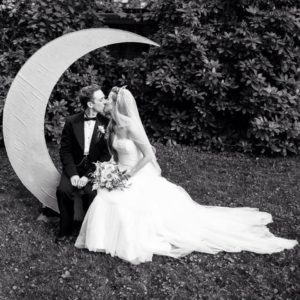
Sarah Olmsted Thomas: I’m Sarah Olmsted Thomas and I’ve been working with Happenstance since 2012. I joined with Alex (company member Alex Vernon), we joined as a team. Outside of Happenstance we make puppet shows together under the auspices of Alex & Olmsted. Beyond that we cobble a living by various sorts of gigs in and out of the theatre arts. Sometimes its workshops and sometimes its commissions.
Alex Vernon: Maybe me next? I’m Alex Vernon, I too have been with the company since 2012. I also build many of the props and sets and moving things for the shows.
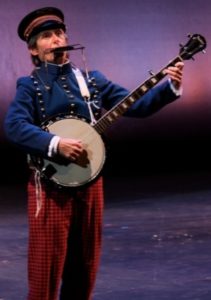
Karen Hansen: My name is Karen Hansen and I have been collaborating with Happenstance since 2009, with Lookout Below. I’ve known Mark (company Co-Founder Mark Jaster) since 1985, 1986—
That’s the year I was born.
Karen: The year Mandy was born! I’m also the company’s music director.
Gwen Grastorf: My name is Gwen. I was going to look up when I started working with Happenstance.
Mark Jaster: It was Proofbox.
Gwen: When was that? 2006? 2007?
Mark: I think it was 2006.
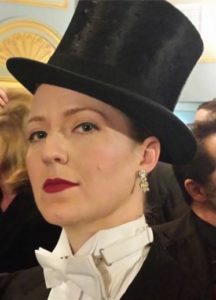
Gwen: I got pulled in kind of slowly. I helped out with a couple of shows, and then some more shows. But it really started ramping up in 2010 with the first Cabaret Macabre.
Mark: Even that was sort of a last minute addition.
Gwen: I was a last minute addition. I’m also the social media person for Happenstance, so I’m always posting pictures on the internet. I do some acting on the side with other companies sometimes. And I have a part-time job with Imagination Stage in Bethesda, that’s my office job, which I enjoy very much.
Mark: I’m Mark Jaster. I’m the Artistic Co-Director and Co-Founder with Sabrina Mandell, who will be here momentarily.
Alex: In fact, there—
Sarah: There she is, rolling up the drive.
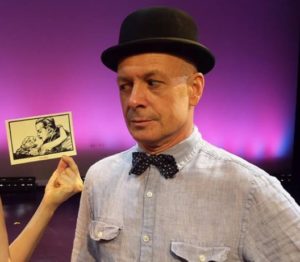
Mark: Ah. Well, I’ve been with the company since the beginning. Which I think was 2006. I think that was our first show. We opened with Proofbox at the Capital Fringe Festival, the first Capital Fringe Festival. That was our first production together and that was the week after Sabrina and I got married. We sort of founded the company because we had such a lively, productive dialogue about work; making work in different ways and doing it with so many ideas that before one idea was even in production we were already into the next one. We decided we should team up. And we’ve been doing it ever since. And here’s Sabrina!
Sabrina Mandell: Hello everybody!
Mark, when you’re not Happenstancing, you do?
Mark: Well, everything sort of falls under the aegis of Happenstance, but I do all sorts of things. Like this morning, I did a couple of solo shows out at a school in Virginia. I’ve done a lot of mime shows, lots of people have seen me do mime shows. All of us do some freelance things out on the side. As much as we would like it to be, or rather many of us would like it to be the central— well artistically it is the central pull for us—
Gwen: It fills the months between shows.
Mark: It keeps the money rolling in. We teach, we consult, we take classes. We perform solo and special events, The Renaissance Festival, those sorts of things. And here’s Sabrina, all settled in now and just in time.
Sabrina: Hello again. I’m Sabrina Mandell.
And you’ve been with Happenstance company since…?
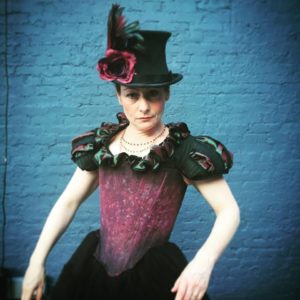
Sabrina: It began. In 2006. I am its mother.
Sarah: Mother earth.
Sabrina: I am the kombucha mother. We have momma and poppa and the kids all here.
Sarah: We’re the babies.
Sabrina: We’re a family. Uncle Milkshake, Auntie Pasta…yeah.
Tell us a little bit about Moxie, what it is and where it came from.
Sabrina: Moxie came from wanting to fill a slot in the calendar that was filled last year by a similar show, a sort of family-friendly, summertime show.
Mark: The circus show, Impossible!
Sabrina: Right. The company was interested in visiting the territory of Vaudeville because we hadn’t done that yet.
Mark: It felt like so much of what we do anyway has a lot in common with the spirit of Vaudeville in that it is performer driven and that rather than long form it tends to be short form.
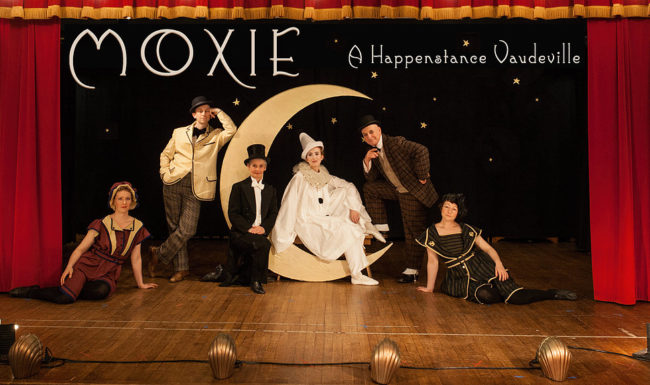
Sabrina: Vaudeville is also interested in being economically viable, commercially, and for-profit, which is a different model than a lot of other art forms.
Mark: It’s also a period that we are drawn to. Aesthetically we tend to think back: vintage, retro. Most of the work we’ve done falls between 1890 and 1930.
Sabrina: And that’s when Vaudeville was happening.
Mark: That’s exactly the arch of Vaudeville. That was another draw for us. Then once we started researching, reading books and seeing videos about it, it was just, “Oh my God, these people have the same values as we do!” They wanted it to be family friendly and we want our work to be accessible up and down the scale. We want scholars to find fun in it and we want kids to have just as much fun and we want it to be a great date show too. We liked that broad spectrum of appeal. Vaudeville had that same target audience of everybody.
How did you go about gathering your inspiration for Moxie?
Gwen: We just collected everything. They ordered some great books. We spent the summer? No, that’s not right—
Sabrina: Fall.
Gwen: That’s right. We spent the fall, the time we were apart after Cabaret Noir, we spent a lot of that time researching. Everybody did a little bit on their own, a little bit of reading the books and watching the PBS documentary. That gave us a broad idea of all the things in Vaudeville that we might want to include in the show. There were so many things! Our original brainstorm document is huge. Then we narrowed it down a little bit because you can’t represent every single type of act there was. But they were all so self-sufficient. One person could have this one act that they did and that was it. They would tour it and take it around and that was their act.
Sabrina: We tried to capture the essence of that.
Gwen: It’s sort of a sampling.
Sabrina: It’s a sampling of Vaudeville styles.
Mark: And issues.
Sabrina: Yes, and issues.
Karen: It’s somewhat chronological too.
Sabrina: It is somewhat chronological. The material isn’t necessarily chronological but the treatments of the material are chronological. The treatments kind of go from an 1890’s treatment to the more 1920’s ‘contemporary’ treatments. For example, we might have a song from the 1920’s that was written in the 20’s or was popular in the 20’s but we might perform it in the style of the 1910’s.
Karen I think I heard you whisper “the name” a bit ago back there. How did you guys arrive at the name Moxie for the show?
Sabrina: Moxie means—
Mark: Chutzpah!
Sabrina: And courage—
Mark: Gumption!
Sabrina: The meaning came after a product—
Karen: A nerve tonic!
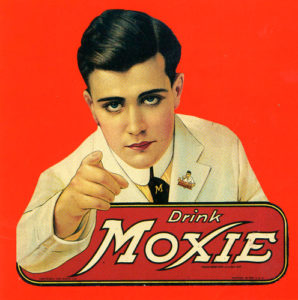
Sabrina: Yes, a nerve tonic called “Moxie Soda” that said it would give you all of that.
Gwen: There were all these ads, if you drank the soda you’d get moxie.
Sabrina: It started in the mid or late 1800’s?
Gwen: Introduced in 1876.
Karen: Gentian root was the main ingredient.
Sabrina: The word ‘moxie’ itself means all those things— courage and gumption and—
Karen: Balls.
Gwen: Plus, it has an old-timey feel to it. And as we discovered with Impossible! It’s good to have a one-word title for the show. It makes the show very recognizable and marketable.
Will Moxie be along the lines of some of the cabaret type performances that we’ve seen from Happenstance?
Sabrina: Theatrical collage is what we’re calling it. That’s kind of what we’ve landed on to describe what we do.
Mark: Vaudeville was separate, unrelated acts. They would have a horse’s act— I mean, we’re not going to have a horse’s act— but there would be horses and then there would be acrobats, followed by a singer, and then there would be a couple who come up and do a comic dance and then there would be—
Gwen: A gymnast.
Sarah: A celebrity!
Alex: Table-jugglers.
Mark: And they had nothing to do with one another.
Gwen: Although they did choose the performance order very carefully. They had specific orders for a seven-act show or a nine-act show. A lot of times it would be something big and crazy to start them out, followed by a quieter number where they weren’t sure if it was a good act or not. If people were new to the Vaudeville circuit, a lot of times their act would go in the second or third slot so that you could test them out. And then the show would end with something more famous. It’s kind of like the way they set up concerts where the headlining band goes last.
Mark: Or they would close the show with—
Sabrina: The person who would guarantee that everybody would leave the theatre so that they could clean up for the next sure.
Mark: Like the guy who played the harp and an ocarina through a megaphone.
Gwen: A really bad act.
Mark: They would use the act to clear the house so that they could get a new group in.
Alex: I remember that the video called it ‘playing to the haircuts’ because that’s all you saw of the audience as they left.
Mark: It’s a collage in that it’s not a linear documentary of the history of Vaudeville, nor is it a story and yet because it’s the six of us doing all these different things, we will come in as one act but we will also come in as other things, but you’ll know it’s still us because that’s the way we do it.
Sabrina: There are some poetic through lines. There’s a thematic continuum.
Mark: There are little historical references as Vaudeville and history moves from the roaring 1890’s, through the first world war, and into the new technology of radio and then suddenly movies—
Gwen: Which heralded the death of Vaudeville.
Is there a Vaudeville act or person that you came across during your research that really stuck with you?
Sarah: Well there is one great character that I remember all of us reading about after Gwen shared that story of the young girl.
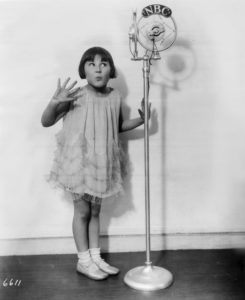
Gwen: The young girl?
Mark: Baby Rose Marie.
Sabrina: She was a famous Vaudevillian.
Mark: She made it all the way into TV later as a commercial girl.
Sabrina: They’re actually making a documentary about her life because her life was so extraordinary. But her story is that she was in the audience as a child. She started singing one of the songs that the performer who was on stage was singing. The performer on stage heard her from the audience and invited her to come up on stage and sing with her. And that was the beginning.
Mark: She was booked then and there, she started performing.
Gwen: There was a whole lot of information about the child stars.
Mark: And their struggles because of Child Labor Laws. They would chase the child stars off the stage at night, say it wasn’t okay, and send the parents to jail.
Gwen: But then there was some parent of the child stars who would just go and pay the bail every night so the kids could be back on stage the next night. I liked the stories of the kind of early feminists, like Eva Tanguay. And Nora Bayes, who with her husband Jack Norworth, wrote “Harvest Moon” and other catchy tunes. But she was billed as “The Fabulous Nora Bayes, assisted and admired by her husband Jack Norworth.” It was just beautiful and fun.
Mark: Some of the really interesting history of Vaudeville happens because it happened during the big immigration period. There were lots of people coming, from Europe of course, but with all of this mixing from all over Vaudeville became this leveled playing field. Anybody from anywhere could make it. If you had some skill, whether it be balancing spoons or playing an instrument or singing a song, you could have your chance at success. For its time, it even crossed the racial barriers way more than other media would. There were some African-American performers who made it big in Vaudeville, like Burt Williams. All races, all media, everybody admired this guy, he was a great comic and a great mime. Anyway, we got all into the history of Vaudeville, we read all this stuff, saw all these clips of these amazing performers, and it’s just incredible.
How would you say that Moxie is going to fit in with what your audiences have come to expect from a Happenstance show?
Mark: Well it— you know, I’ve been doing a lot of the talking, does someone else want to start this one? Anyone want to jump in?
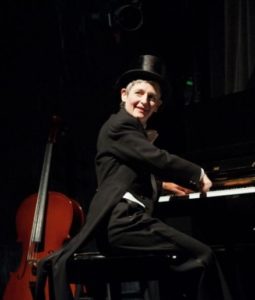
Karen: Musically, we kind of discovered that there was no orchestra. It was just a pianist and some sheet music, a really hard-working pianist. So I’m not playing a bunch of instruments this time around, well a few. A lot of the music is from the 1910’s, which is a new genre for me. It’s very different from the 20’s. It has an earlier feel. There are a lot of rags. We’re also doing some classical things, like Mark playing the saw and myself on piano, a combination which we haven’t explored. The sheet music covers of the period are hilarious.
Alex: I think our audiences have definitely come to expect all of us to play multiple characters.
Gwen: We’re doing that!
Alex: They expect us to have an impossible number of fabulous costume changes, and sort of accomplishing high-skill through more essentialized theatrical means rather than actually doing the thing.
Gwen: We’ve got some physical comedy, a lot of songs, we’ve got some harmonies, we’ve got some verbal comedy; we try to make a decent mix of stuff to watch, stuff to listen to, stuff to see.
Sabrina: There’s a lot of music in this show.
Mark: As there was in Vaudeville.
Sabrina: This show actually has more group numbers than we are accustomed to. There are more full company members than we normally have.
Gwen: Which is good and a lot of fun for us to learn but it’s harder for costume changes. If all six of us are on stage, no one can be off changing. So now we’re having to build in someone leaving early or someone staying on after. This is part of how we build our shows, thinking about the logistics of how if we all six do this thing together, we need a couple people to remain while the others change into the next thing.
What would you say has been the biggest challenge about creating something unique?
Sabrina: Time.
Karen: It takes so much time.
Alex: And not falling into old habits. “Oh this is a show made of smaller pieces” but how do we make it different from other shows that we’ve done that are made of smaller pieces, and finding ways to keep doing that without doing the same thing.
Karen: For me, not worrying about not playing enough instruments. It feels right because that’s not what this is about.
Gwen: We do struggle with this interesting notion of not wanting to pander to our dearest fans? We don’t want to necessarily repeat stuff we’ve done in the past, we’re always trying to change it and to do something new, but we’re still trying to honor the patterns and beloved qualities and dynamics that they like from previous shows. It’s kind of a delicate balance.
Mark: We do like to explore the territory. When we were doing the circus show we looked at all these circus posters, and the circus books, we read circus stories and learned circus vocabulary. From that we drew our inspiration and pulled the essential elements of what makes a circus show. The same is happening here with Vaudeville. It’s less familiar in a way because none of us have ever seen a Vaudeville show. I sort of hope that people expect to move into the territory with us. When we moved into circus with Impossible! or when we moved into film noir with Cabaret Noir they went with us. I hope they’ll want to know what our take on Vaudeville is going to be. We bring our own quirky imaginations and skills to the exploration of that. It’s still us, but it’s a different territory that is maybe les familiar to our audience.
Is there a moment in the show that speaks to each of you and defines what Moxie is for you?
Sabrina: I don’t know that I’ve discovered that yet. I think I need to feel it with an audience to know.
Gwen: There are a couple things about the passing of time, I think. It’s hard to get into Vaudeville without getting into the “end of Vaudeville” that’s tinged with sorrow and saying goodbye to this old format. I love the songs so much. I think the songs of this era are so beautiful and I love singing the harmonies.
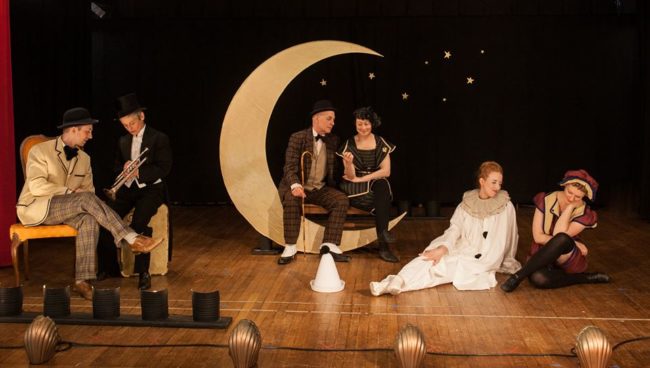
Sarah: I do agree with Sabrina. We will learn so much once we have an audience so I don’t know if I can pick a favorite moment yet. I do have on rose-colored glasses right now because Alex and I just got married so I’ve been seeing this show as a love show. It felt like that, assembling it with the company, like it has a rosy quality to it. I think there’s a romance to it that’s very palpable, even though— like Gwen acknowledged— when you hear the word Vaudeville you think nostalgia and melancholy and times bygone. These are times that won’t come again. I suppose there is a celebration in that thought process of loving the times that we have now. That also resonates as a familiar theme we’ve been working through, which is using the past and using nostalgia as a way to be more present and more in the room.
Mark: Nicely put.
Alex: I think what really makes it meaningful to me is that it’s not just a variety show where it’s a sequence of random fun acts. We do get to revisit some of the characters at different points in their life and follow them along their journey. We get to see how their work has changed them and how they’ve struggled to adapt or keep up with that.
Did you want to talk a little bit about Woody, Alex?
Alex: Oh yeah! So Woody is a ventriloquist dummy! I forget when exactly he came about, he was added fairly late in the process. I think we realized we needed one more act before the final finale, just to help cover some costume changes. The main thing I always think of when it comes to Vaudeville is a ventriloquist act, it’s just so classic and so evocative of that period. I built Woody in my workshop. He’s about 20 inches tall. He was really fun to build. It was my first time building a ventriloquist dummy. He has a moveable mouth, eyes that look left and right, and eyebrows that raise and lower.
Mark: And he’s nothing but trouble!
Karen: You can say that again.
Mark: Woody is trouble.
Sarah: Woody!
Alex: Maybe you can interview him.
Karen: You should definitely interview Woody.
Sarah: You need to interview him!
Mark: Does your recording device have a bleep function?
Alex: Backstage we might need a bleep function.
Karen: He’s laconic.
What would you say working on Moxie has taught you guys about yourselves as performers, as human beings, as ensemblists?
Sarah: For one, it has re-taught me something I have gleaned throughout my lifetime, which is I am better as part of a group. Even with family, I find I’m just a group-oriented gal. I put a lot of time into them. Happenstance is like a family too. I recognize we all bring a set of skills and strengths that someone else doesn’t have but collectively we’re so much stronger and so much more exciting. The possibilities are exponential than what they are as an individual with a solo work. Having a group that I belong to is incredibly encouraging and it’s an encouraging group of people. I brought back an accordion a couple years ago from Vermont, and Karen said, “Alright, let’s have you play it in a show.” As if I could play accordion! And now I do! There’s that encouraging sense among all members. Gwen learned piano, she was playing it in Cabaret Noir. And it’s not just with instruments.
Mark: Yeah, I hadn’t done a handstand in a long time, and we realized it would be better if my character did this handstand thing that Alex had invented in BrouHaHa and we worked on it and now I’m doing it.
Alex: I think the best thing about working in an ensemble like this is that it’s not just a performer ensemble. We’re all creating the work together too.
Karen: Everyone has such varied skills. It’s amazing. It’s perfect.
Gwen: And that’s very malleable too. We discover all the time how everyone can help with different stuff. We can expand a skill that we don’t necessarily have or are good at. Especially with the musical skills, but even beyond that, there’s building and painting and all of those.
Karen: Sabrina could use some more administrative help, but I think that comes later as we grow.
Alex: Even the non-physical building, like crafting these pieces with storytelling structure, I think we’re all getting stronger and better at understanding how each other works. We’re really getting a better eye for that kind of thing.
Gwen: You know, when we look back at the first Cabaret Macabre that this group of six made together, there are moments where we say “Oh, that wasn’t really a group singing number. Why didn’t we do that then?” We were still getting to know each other then whereas now it makes so much more sense to have a moment like that be a group number.
Karen: Yeah, I didn’t know these guys, Sarah and Alex, then.
Gwen: It used to be, before this company was fully formed, Mark and Sabrina used to work with different people every year. They’d invite some people over to play.
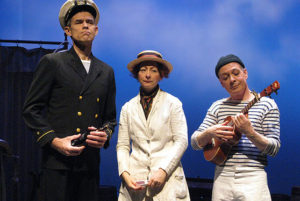
Mark: Along the lines of “who do we need for this particular project.” When we did Low Tide Hotel, which was our second Fringe year, we knew we wanted to do Maritime stuff and we knew we wanted it to have someone with a strong voice. My friend, Scott Sedar, was interested so we asked him to come and play.
Gwen: Gorgeous voice.
Mark: He had a beautiful baritone. And he’s really tall. Sabrina and I are not tall. So we did this really fun trio where we divided up these characters and built up a collage. Getting back to the company, all of us are very “hands on.” We like to do it all, we don’t want to just learn our part and do our thing. When we’re choreographing something, there isn’t one person standing out saying “you will do this, and then you’ll do this,” with everyone standing around saying, “Okay, if that’s what he or she wants I’m going to do it.”
Gwen: It’s by committee.
Mark: By committee— actually, I would say by consensus.
Gwen: Ah. Yes, consensus.
Mark: When we disagree on something, unless somebody is really willing to say “it doesn’t matter that much to me” we keep working at it and changing it until we’re able to agree on it. Usually what happens is I think it ought to be this way, so-n-so thinks it ought to be this way, and they’re different. And we say “well this is why” and then someone else will say “well what about this way.” And by the third way or the fifth way we end hitting a “Oh, cool! That’s the way we should do it!” And then we add it into the work.
Gwen: That’s something that has come up over the years with that process. We used to build a show in about two months, now we build a show in about five months. With our devising process, we’ve built in time off between stages of building the piece. We research for two weeks, then take a month off, and come back to it. When we come back to it, sometimes solutions just present themselves.
Karen: You know what else has been fun? The scholarly stuff. After we have these brainstorms and I go home to Vermont to start researching things, thank God for the internet—
Wait a minute, you’re not local?
Karen: No. I don’t live here. So we do a lot of things by email. It’s a nine-hour work commute.
Mark: We have a spare room here in the house so she stays when she comes down.
Karen: It’s nice that we can communicate when I’m not down here though. I like history and researching music. I think everyone sort of does enjoy the history of this period.
Gwen: Technology is our friend. Karen makes us MP3 recordings.
Karen: We have a lot of ways of communicating to make these things, it’s good. We’re lucky.
Alex: Since we own the work completely we can continually change and tweak things through the last show.
Mark: Or right before we open.
Sabrina: Yes! It’s constantly growing.
Karen: We’re getting better at documenting things too.
Gwen: Google Docs.
Mark: Google Docs and what’s the one with the video?
Sabrina: Vimeo.
Mark: Those two. We document things there.
If you guys could sum up the experience of Moxie in just a few words? A sentence or so?
Gwen: For an audience member? Or for ourselves? I think there’s something about risk in it for me. A lot of these Vaudeville performers had their lives and livelihoods on the line. A lot of our performers are a little desperate but in a kind of beautiful way. They’re out there doing their weird act, singing their heart out—
Karen: With their duck under their arm, which they make quack…
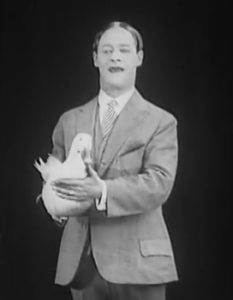
Sabrina: That’s not in the show.
Gwen: We almost had the duck! What were we going to call him? Henry thumbs and his performing duck?
Mark: Randy Thumbs and his Performing Duck.
Gwen: He did get cut.
Mark: There is a clip of a Vaudeville performer, Gus Visser, in this duck-umentary
Sabrina: Quack!
Alex: Quack! Quack! Quack!
Mark: This guy would sing a song and then on cue, the duck in his arms, would quack. It was pretty funny and very ridiculous.
Gwen: There is something very “American Dream” about that. You know, “I’m going to get up there and show them what I got!”
Mark: I can dance my heart out or I can sing.
Sabrina: It’s like America’s Got Talent or American Idol. It’s part of that same tradition.
Mark: Anyone could see themselves on the stage. You didn’t have to be anyone—
Alex: Anybody could be a star.
Mark: And some of them were. Some of them went on to TV and films.
Alex: But not everybody can be a star.
Karen: So true.
We will be seeing lots of movement in true Happenstance form?
Mark: Oh yeah. Movement, song, spectacle, costumes. A lot of vintage costumes, a lot of new comedy.
Sabrina: I think it’s on par with Impossible! For hats and costumes and shoes. Well, not as many shoes as Impossible! That show had like 50 pairs of shoes going on.
Sarah: So many shoes. Pay attention to the shoes.
Sabrina: Don’t pay attention to the shoes in this show.
Anything that you’d like to say about the collaborative effort of Happenstance? What it’s like to have Happenstance as your life?
Sabrina: I want to say something about that. It feels to me like we, in a lot of ways, are meeting our stride. We’ve met our stride. Oh my, you’re going to have to edit out all that background chatter!
Sarah: Husband!
Alex: Yes, wife?
Sarah: Your presence is expressly requested.
Alex: Excuse me, I have to do my husbandly duties.
Sabrina: See? Now, where was I? Oh, yes. It feels like we’re really hitting our stride as an ensemble in terms of our collaboration. It feels like we all really know each other well now and can sort of anticipate the needs of people. In a way that has made the process a lot easier because we’re all giving each other a lot more space around all of the “real life” shit that comes along with it. We’re really like a family, we’re a pretty intimate thing. We’re making work that is very important to us.
Mark: It’s us in there. It’s our hearts and our ideas and our concerns and our obsessions and our skills. It’s personal.
Sabrina: Right, exactly. It’s personal. Which means that the process can then be personal but we’ve been through it now the right amount of times that it definitely feels like there is more ease around it than there has been in the past. There is no way we could do what we’re doing without having built such a strong ensemble.
Mark: We hit the ground with a common vocabulary. It’s a new project but we know each other, we know our weaknesses and strengths, we know our issues, and the dialogue has begun.
Karen: It’s very hard to explain, but we share this aesthetic. And also, it’s not going to last forever.
Mark: That’s true too because nothing does.
Sabrina: Nothing does.
Mark: Our work is always shouting that, “Nothing lasts forever!” In a way, I would say that Moxie! is sadder than most of our pieces.
Sabrina: Yeah, there’s something fleeting and sadder about it.
Karen: Well, it’s a certain melancholy. It’s still hilarious.
Mark: Yeah, it’s hilarious too, but it does trace the arc of Vaudeville. It starts, it’s flourishing, and then it’s dead.
Alex: I hate to interrupt, but I think Woody has decided he’d like to be featured before you conclude this interview.
Oh my goodness. Here in the flesh— the wood? Well, alright, why not? Welcome to the interview, Woody.
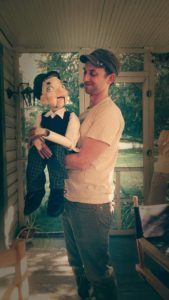
Woody: Oh boy!
And how long have you been with Happenstance Theater, Woody?
Woody: I guess about a yard? Ha. Ha. Ha.
Are you excited about getting to perform as a part of Moxie!
Woody: Oh boy. I’ve been doing this shit for about 50 years!
50 years??
Woody: Oh yeah. And I’ve been stuck with this guy, he’s the worst!
Alex: Woody!
Mark: I told you.
What’s your favorite part about the show, Woody?
Woody: Oh boy! There’s this great act at the end with a real dummy! It’s this guy!
Alex: Woody!
And you like getting to work with Happenstance? Who’s your favorite person in the company?
Woody: Uh…oh boy…um…
Sabrina: Me! It’s me— I’ll pay you later, Woody.
Woody: Oh yes! Sabrina! She’s my favorite! But I think it’s actually the stage manager gal!
Oh really? What’s the stage manager gal’s name?
Woody: Oh boy! I don’t know, but she’s the last to leave and then I get the whole place to myself!
Anything else you’d like to say to us about getting your big break with Happenstance?
Woody: No!
Anything else that anyone else would like to say about anything? About Woody? About the show? About winning Helen Hayes Awards? About anything?
Sabrina: It takes a village!
Karen: Look at all these fabulous people who are helping us right now.
Sarah: It takes a village!
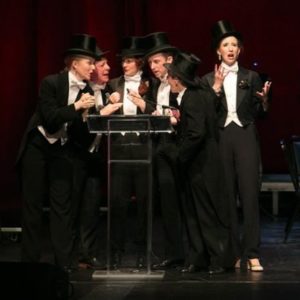
Mark: Sabrina, do you want to go around and introduce the others here with us?
We have had a handful of lovely silent people in and out of this interview today, would you like to introduce and include them now?
Sabrina: Yeah. We have this incredible stagehand who is actually helping with ton of production stuff, named Evangelina Hakes. Say hello, Evangelina.
Evangelina: Hello.
Sabrina: And she rocks. Then we have our incredible Stage Manager who is going to tech this beast!
Sophia Lewin Adams: I am! I am!
Sabrina: Sophia Lewin Adams.
Karen: Sophia Rose.
Sophia: That is my middle name! And hello, everyone!
Mark: The tech for this show is complicated because Roundhouse is moving us in right after they close the last show of their season so it limits—
Sabrina: We have one day of tech. It’s impossible, but we’re going to make it happen.
Alex: Impossible, you say?
Sabrina: But it takes Moxie and that we’ve got! The other two people who are incredibly invaluable are Nancy Mendez, who is inside right now helping to construct all of these costumes.
Mark: She built all those headdresses that you just saw come parading through.
Ah, yes. The glorious sun, moon, and stars on parade. The readers are just going to have to come see Moxie to know what we’re talking about here, won’t they, Mark?
Mark: Yes they will!
Sabrina: Exactly. And then there’s Nancy Rodrigues, who is basically my right hand man. She does everything for me.
Mark: She went and fetched the dinner. She does the filing. She’s here today to help paint and stitch, she made the flags that Alex and I need in our Alpine number, she’s great.
Anything else? Did we forget anyone? Forget to mention anything?
Mark: Do not forget that you will get to hear Gwen Grastorf yodel. That’s a selling point.
Oh! Thank you, Mark! I nearly forgot the closing question! Why should people come and see Moxie: A Happenstance Vaudeville?
Gwen: Yodeling. I spent six hours learning how to yodel on the drive to Massachusetts.
Karen: It’s really fun. You’ll laugh. Everyone will laugh, kids, old people, everybody.
Sabrina: Laughing! There will be laughing!
Sarah: It’s the medicine that does a body good! Laughing and laughing together in a room full of people having fun, that’s the dream!
Mark: It’s a reminder of how fleeting everything is.
Alex: And there are ladies in bathing suits in the show!
Mark: Oh yeah. Oh! And guys! There are guys in bathing suits in the show.
Sarah: There’s something for everyone.
Mark: But don’t worry, no ankles will be shown!
Evangelina: It’s going to be a grand old time!
Sophia: I think it’s going to be a lot of fun and it’s not something you’re really seeing anywhere else.
Karen: That’s the truth!
Sophia: Everyone who is in it is just so good! And I’m so excited to see it come together.
Alex: Us too!
Mark: Here’s hoping!
Moxie plays June 24 through July 17, 2016 with Happenstance Theater on the main stage of Round House Theatre— 4545 East-West Highway in Bethesda, MD. For tickets call the box office at (240) 644-1100 or purchase them online.

